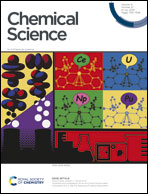Enantioselective isothiourea-catalysed reversible Michael addition of aryl esters to 2-benzylidene malononitriles†
Abstract
Catalytic enantioselective transformations usually rely upon optimal enantioselectivity being observed in kinetically controlled reaction processes, with energy differences between diastereoisomeric transition state energies translating to stereoisomeric product ratios. Herein, stereoselectivity resulting from an unusual reversible Michael addition of an aryl ester to 2-benzylidene malononitrile electrophiles using an isothiourea as a Lewis base catalyst is demonstrated. Notably, the basicity of the aryloxide component and reactivity of the isothiourea Lewis base both affect the observed product selectivity, with control studies and crossover experiments indicating the feasibility of a constructive reversible Michael addition from the desired product. When this reversible addition is coupled with a crystallisation-induced diastereomer transformation (CIDT) it allows isolation of products in high yield and stereocontrol (14 examples, up to 95 : 5 dr and 99 : 1 er). Application of this process to gram scale, plus derivatisations to provide further useful products, is demonstrated.

- This article is part of the themed collection: Celebrating the scientific accomplishments of RSC Fellows


 Please wait while we load your content...
Please wait while we load your content...